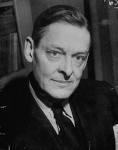Recently several colleagues have wanted their sessions to generate creative material for presentation. Often there are disparate topics/themes/threads to explore. There are many, many ways to do this. Here’s one which introduces and uses the principle of Elliot’s Objective Correlative.

It expands the power of observation and connects craft to art in an adventurous and fun way. I’ve used this many times and have been thankful for the old man’s contribution.
In particular I’ve used the principles involved in Elliot’s Objective Correlative to explore seemingly unconnected themes, events, situations, things or narratives.
I first explored Elliot’s idea in grad school but realized that, as a theatre creator, I’d been using the concept for a long time. In fact, I’m not sure how theatre – or any other art – could be done without finding an equivalent in the physical world for emotional states. That’s our whole business. Elliot writes, ““the only way of expressing emotion in the form or art is by finding an ‘objective correlative’; in other words, a set of objects, a situation, a chain of events which shall be the formula for that particular emotion; such that when the external facts, which must terminate in a sensory experience, are given, the emotion is immediately evoked” (Selected Essays, [London: Faber and Faber, 1951], pp. 144-5).
So, the other day, when a colleague presented me with two emerging narratives and themes, she had questions as to how to proceed in her class’ exploration. Being an old hand at Collective Creation, perhaps my exercise below can help. Part of her goal is to generate original materials while exploring the themes of man-made social constructions (as reflected in our dependence upon technology) and our more authentic, wild selves as represented by the Forest of Arden in As You Like It.

Pantea Karimi: As T.S. Elliot Imagined
Exercise – Finding it in the Real World
created by thom vernon
Point of Concentration: to explore the emerging themes by finding real world counterparts (things, events, sequences, sounds, etc.) which evoke a sensory experience informed by emotion.
Uses & Applications: Exploration of Themes, Generating Original Material, Improving Observational Skills, Critical-thinking
Directions:
1. Have a brief discussion about the themes/topics to be explored. Let’s say ours is: Techology vs. Authenticity. Have the discussion through an exercise (such as creating a collage around the theme or a relay improv scene). Get the topic introduced but don’t overtalk it.
2. Send your class out as individuals or pairs to notice technology (or whatever your theme is) in the world. They are to make lists of their observations. Additionally, they might go further and notice where/how technology influences interpersonal relationships. Participants could create a list of at least 5 technological referents (two lamps twisted around each other, a person texting, a power outage, a car slamming on its breaks, etc.).
3. The next step is to do the same with the Natural world. Find trees with large knots, a sprout pushing through snow, a rotten apple, etc. Go futher and notice the Natural human world: a hand on an arm, intimidation, no eye contact between two people, a peck on the cheek.
Remind participants that they are specifically looking for objects/events/situations, etc. which could elicit a particular emotion and probably evoke an emotional response. Encourage your explorers to be as specific as possible.
4. When the participants return, ask them to brainstorm emotions/themes etc. that could be attached to their observations.
5. Finally, ask participants to test their objective correlatives by creating tableaux, portraits, monologues, short scenes, newsarticles, short stories, poems and so on including at least four of their observations. They can work individually, in pairs, or in small groups. I’d suggest using at least two or so opposing observations (e.g. Technological & Natural) from one or two participant lists.
6. Participants can present their works and then after reflect, as a group, upon their experience.
I highly recommend using the material generated in your collective creation or as a basis for further exploration.









